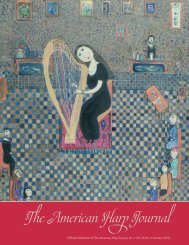The American Harp Journal - Extras - Summer 2017 (revised)
Supplement to Vol. 26 No. 1 (Summer 2017) of The American Harp Journal (revised)
Supplement to Vol. 26 No. 1 (Summer 2017) of The American Harp Journal (revised)
You also want an ePaper? Increase the reach of your titles
YUMPU automatically turns print PDFs into web optimized ePapers that Google loves.
<strong>The</strong> <strong>Harp</strong><br />
In France in 1581, the harp was the instrument of<br />
choice for royalty and the aristocracy. <strong>Harp</strong>s became<br />
easels for artists who lavishly carved and decorated<br />
the instruments. Playing the harp in their private<br />
musical salons allowed performers to show off their<br />
lavish clothing and fashionable coiffeurs as well as<br />
their elegant arm movements. Included among these<br />
amateur harpists were Queen Marie Antoinette and<br />
Empress Josephine Bonaparte. <strong>The</strong> popularity of the<br />
harp created a demand for harp makers and teachers<br />
as well as professional performers who were increasingly<br />
needed for ballet performances.<br />
<strong>Harp</strong>s available at the time were diatonic and capable<br />
of producing the basic harmonies of the period,<br />
but needed to be retuned for each key. Many harpists<br />
played both harp and chromatic keyboard instruments<br />
and even wrote pieces playable on either instrument.<br />
But as harmonies grew more complex and<br />
audiences more sophisticated, all instrument makers<br />
were challenged by the demands of composers’ use of<br />
chromaticism as well as the need for increased volume<br />
and standardization of intonation.<br />
To enable chromaticism, different harp makers<br />
added rows of strings, hooks, levers, and, ultimately,<br />
pedals connected to a disc-and-fork mechanism<br />
that led to the double-action pedal harp made by<br />
Sébastien Érard in England in 1810. That harp is still<br />
the prototype for today's classical harp makers. <strong>The</strong><br />
harps were also increased in size and given greater<br />
string tension to increase their volume. Unfortunately,<br />
the resulting harps were more difficult to play,<br />
which caused the elite ladies and gentlemen of the<br />
salons to turn to the easier-to-play pianoforte as their<br />
instrument of choice. But many professional harpists<br />
embraced these new attributes of the harp and wrote<br />
pieces that created an instrumental language that is<br />
unlike that of any other musical instrument and is, in<br />
fact, still being explored and expanded today.<br />
Creating a Ballet<br />
<strong>The</strong> process of creating a ballet began when the<br />
choreographer chose a story. A dramatist or scenarist<br />
wrote a stage version of the story. <strong>The</strong>n the<br />
choreographer envisioned detailed scenes for active<br />
storytelling and separate pieces for pure dancing.<br />
Composers such as Riccardo Drigo (Le Talisman),<br />
Ludwig Minkus (Don Quixote, La Bayadère), Adolphe<br />
Adam (Le Corsaire, Giselle) and Leo Delibes (Coppélia,<br />
Sylvia) were connected to individual ballet companies<br />
and wrote within the formats required by each<br />
ballet’s creators, earning them the title of “Specialist<br />
Composers.”<br />
<strong>The</strong> music composed for ballets was considered<br />
flexible and was often <strong>revised</strong> or rewritten to serve<br />
the creative desires of the choreographers and directors<br />
of the productions. This customization of the<br />
music could include the addition of supplemental<br />
dances requested by individual dancers, which then<br />
became the legal property of that dancer.<br />
<strong>Harp</strong> Cadenzas<br />
As the art form of ballet evolved, the harp became<br />
a featured instrument for several artistic reasons.<br />
<strong>The</strong> harp’s timbre and presence already had ethereal<br />
associations and therefore was the perfect partner<br />
for those fairy tale plots in which sylphs, willis, and<br />
fairies danced. In these ballets, the entrances of the<br />
stars, both male and female, were designed to stop<br />
the show and to suspend all action in order to focus<br />
attention on the star.<br />
In general, these celebrity entrances were lightly<br />
choreographed or mimed announcements to the<br />
audience that the dancer they had come to see was<br />
now on the stage before them. He or she was then<br />
greeted with spontaneous and enthusiastic applause<br />
from the audience. <strong>The</strong> natural choice to accompany<br />
these fanfares was graceful and elegant harp music in<br />
the form of a cadenza.<br />
<strong>The</strong> harpists who performed these cadenzas, like<br />
the composers, had to be flexible and ready to customize<br />
their parts. By choice or by assignment, they<br />
created their cadenzas in collaboration with the solo<br />
dancers and choreographers. <strong>The</strong>re was a general<br />
structure for these and later cadenzas, as shown in<br />
the cadenza from Le Corsair by Adolphe Adam.<br />
See Example 1: Cadenza from Le Corsair by Adolphe<br />
Adam.<br />
4 THE AMERICAN HARP JOURNAL – EXTRAS




